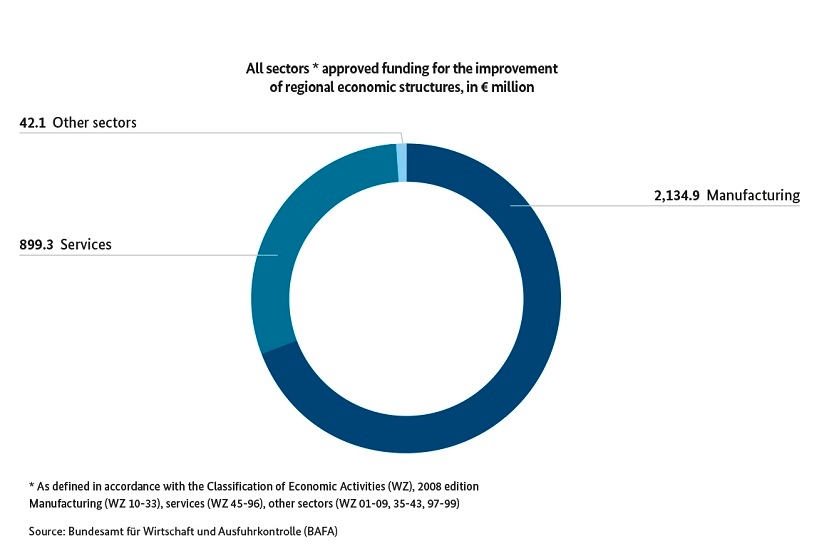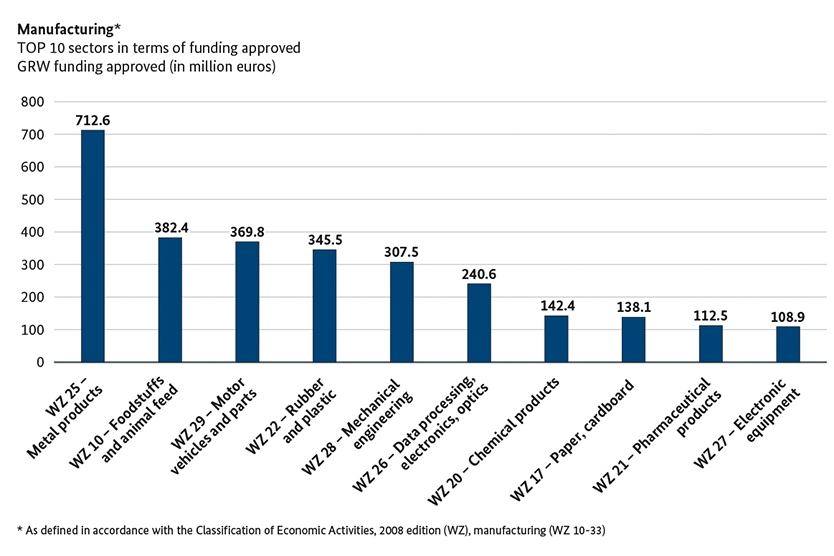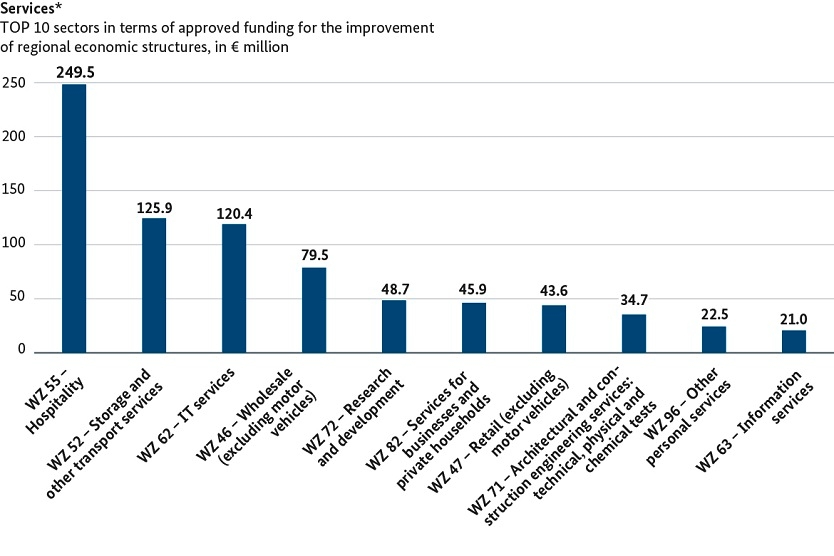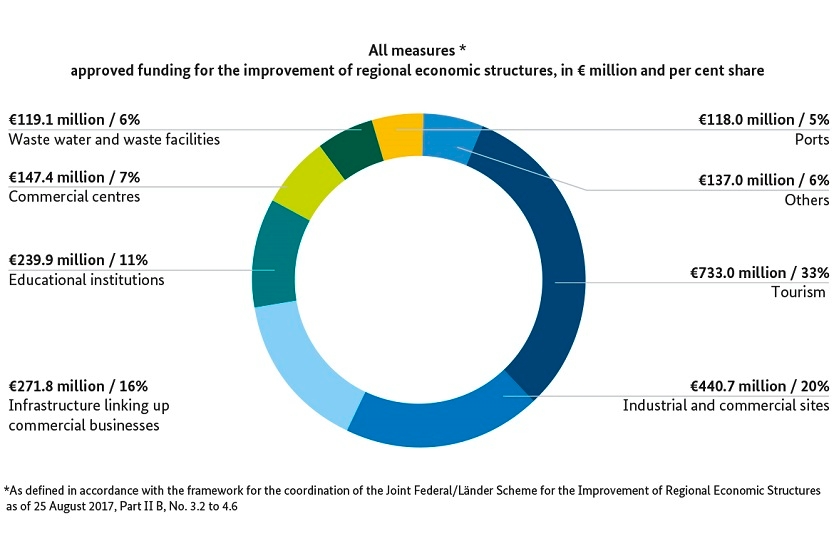GRW funding is dedicated to those regions that are structurally weak. The idea behind it is to boost investment activity in the region, which in turn will generate attractive local jobs for the long term.
A broad range of funding instruments is available
For regional policy to be effective, it needs to take account of the unique conditions and challenges in terms of structural change that exist in any particular region. The GRW therefore offers a very broad range of funding instruments and strategies that regions can use to meet their specific needs.
GRW funds are used to support investments by trade and industry, investments in local commerce-related infrastructure, measures designed to encourage networking and cooperation between local players, and measures designed to improve competitiveness, particularly that of SMEs.
- The idea behind supporting investments by trade and industry is to provide incentives for companies to invest in regions that are structurally weak. This helps with the structural change that is needed for growth, employment and local income.
- Building a strong commerce-related infrastructure is essential for weaker regions to be able to attract companies and thus become more competitive.
- Non-investment measures that facilitate greater networking and cooperation among local players (e.g. by means of development strategies or within regional management bodies and innovation clusters) help improve the local business environment.
The basic guidelines for the GRW, the map of Assisted Areas, the instruments available and the rules and maximum funding rates that apply are all set out in the “coordination framework” (PDF: 1 MB) which is agreed between the Federation and the Länder. The funding rules transpose the European rules on national regional aid into national law.
The exact terms and maximum rates of funding that apply under the GRW vary depending on the level of structural weakness/needs of the region.
The coordination framework in place since 1 January 2022 has expanded a range of eligibility criteria in order to further improve and provide increased flexibility to GRW investment assistance in terms of its applicability and effectiveness. Among other things, it is now possible to support the upgrading of state roads to better connect commercial areas to the supra-regional road network. Personnel costs for participants during corporate training measures can be funded in part, with the maximum funding amount doubled to €200,000. This creates improved incentives particularly for SMEs to enhance their competitiveness by conducting training measures. Also, the funding amounts for the elaboration of integrated regional development concepts have been doubled from €50,000 to €100,000 to enable a broader engagement of citizens and companies.
There is no legal entitlement to funding under the GRW. Funding is provided in the form of grants or low-interest loans and is financed half and half by the Federation and the Länder.
New map of Assisted Areas shows which regions are eligible for support
In line with European provisions under state aid law, the new funding period 2022-2027 has begun as of 1 January 2022.
The map of Assisted Areas (PDF: 2 MB) shows the current area receiving funding as of 1 January 2022.
- All eastern German regions (except for parts of Berlin) continue to form part of the GRW areas. The eastern German Assisted Areas reflect the fact that it is particularly the major cities and their conurbations that are enjoying a favourable economic development.
- Structural change in regions characterised by old industries – such as the Ruhr area – will receive greater support under the GRW.
Depending on the class of Assisted Area a region belongs to (which itself depends on its level of economic development) and on the size of the company receiving the funding, different maximum funding rates apply when it comes to aiding investments by trade and industry. Small and medium-sized companies are eligible to receive higher rates of funding than large companies.
To draw up the map of Assisted Areas, the level of structural weakness for each region was assessed on the basis of a uniform national procedure in line with the provisions of the EU’s regional aid guidelines. A complex system of mixed regional indicators (based on regional productivity, the underemployment rate, demographic development and the quality of infrastructure) is used to rank regions according to their overall performance, from the weakest region (structurally and in terms of economic performance) to the strongest region.
The current assessment of regions’ structural weakness follows on from a review of the regional indicator model based on the academic study “Betrachtung und Analyse von Regionalindikatoren zur Vorbereitung der Neuabgrenzung des GRW-Fördergebiets ab 2021 (“Raumbeobachtung”)” (Consideration and analysis of regional indicators in preparation for the redefinition of the GRW Assisted Areas from 2021).
The GRW looks at the economic performance of “labour market regions”. This serves to prevent any statistical distortions owing to differences between place of residence and location of employment. As part of preparations for the new funding period, the Federation and the Länder have updated the delineation of the labour market regions on the basis of a study by RWI – Leibniz Institute for Economic Research. Given increased commuter activity, there are now only 223 labour market regions (previously 257) (PDF: 162 KB).
The Länder are in charge of allocating GRW funding
Notwithstanding the national framework that has been agreed between the Federation and the Länder, Article 30 of the German Basic Law applies, which stipulates that responsibility for fostering regional economic development lies primarily with the Länder. As a result, the task of administering and managing GRW funding is reserved to the Länder. Within the bounds of the legal framework established by the Federation and the Länder, each Land is free to target funding at certain areas or at meeting certain objectives. The Land or the region in question decides for itself which projects are to receive what amount of funding, issues letters of approval, and verifies that beneficiaries adhere to the terms under which the funding has been approved (cf. “Länder-specific rules and information issued by the Länder”).
Studies concerning the entire GRW provide the federal and Länder governments with guidance and in-depth information on specific issues relating to the implementation of GRW assistance. For example, a 2020 study entitled “Wirtschaftlichkeitslücke und Wertabschöpfung bei der GRW-Infrastrukturförderung” (Profitability gap and value absorption in GRW infrastructure funding) identifies good funding practices and makes recommendations for the practical application of the rules on the profitability gap and value absorption within the coordination framework.
Regional policy – figures and review system
The amount of funding for investments by trade and industry approved under the GRW between 2016 and 2020 totalled around €3.3 billion. It helped leverage an overall investment volume of nearly €20 billion, create more than 50,000 permanent jobs and safeguard more than 180,000 existing permanent jobs. Over the same period, GRW funds worth roughly €2.8 billion were approved to support investments in commerce-related infrastructure totalling nearly €3.9 billion.
The GRW funding scheme is reviewed by external experts at regular intervals. In its evaluation study released in 2020, the Halle Institute for Economic Research (IWH) shows that employment growth in companies funded under the GRW remains almost twelve percentage points stronger for up to five years after the end of funding than in similar companies that are not being supported. GRW funding also has a considerable positive impact on turnover growth. The findings confirm the conclusion of previous evaluations that the GRW scheme helps to create new permanent jobs in regions that are structurally weak.










